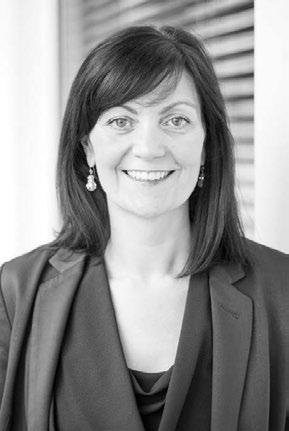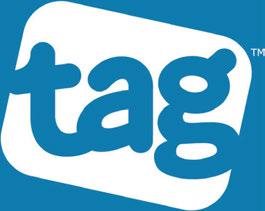
22 minute read
The State of Play
Abbie Heppe, Media Molecule

Advertisement




Rebecca Sampson, Hangar 13
AN IMAGE OF SUCCESS
Putting women (and others from diverse backgrounds) in leadership positions is important, of course. But we also need to tackle a culture that has a very specific image of what a successful person in the industry should look and act like.
“The science says that diversity of gender, (along with all kinds of diversity) leads to a stronger performing organisation creatively and commercially,” says EA’s Channon, “but I worry that there’s still a sense that to succeed as a woman in our industry we often need to exert stereotypically masculine traits, of which there are already too many in games.
“When we reach a space where what are usually thought of as traditionally feminine attributes are no longer seen as a weakness and can be given space, be nurtured, accepted and rewarded for the tremendous positives they can offer in their own right, well that really will be progress. “Until we get there we all need to do and say more. We need to feel confident and comfortable in calling each other out on our behaviours, on checking our language, our approach and the support we show for individuals of every gender. I am immensely impressed by the way women, and in particular women in the generation below mine, have taken this on and challenged the status quo. The work they have done to redefine and interrogate the way we all think about issues of gender, power and representation is one of the most positive developments of recent times.”
This issue of having to “exert masculine traits” is likely a symptom of the same perception issues that have kept many women out of the industry entirely.
“Diverse people in games, specifically when it comes to women, are still greatly underrepresented in the industry and especially for those directly involved in development” says Amiqus’ Liz Prince.
“When we look at the causes of these low numbers we’re faced with perception issues, low visibility of games as a career for entry level and experienced women,


















parental influence to go into a ‘proper job,’ games being seen as a niche choice perhaps only for gamers, games are for boys or maths geeks and girls don’t think they’re any good at maths, the hours aren’t family friendly, there’s inherent sexism in games… the list goes on. These issues and more impact our ability to build pipelines of female talent and to retain them in games as their lifelong career.”
While there are companies pushing for change, it’s important that businesses of all sizes not only seek change, but truly understand the problems they are trying to address.
“I feel that our industry is changing,” notes Teazelcat’s Azhar, “but that the majority of change is coming from smaller studios. While large companies are hiring diversity officers, creating internal diversity groups and offering non-bias training, these are things that can exist in the company without the majority of the workforce engaging and really understanding the problem and thus fail to change the studio culture.
“I continually encounter developers who don’t understand the additional challenges faced by underrepresented people getting into and advancing within the games industry. Without being given the knowledge of why it’s important for their company to make change, continual support on changing behaviours and ideas in the workplace (such as hiring and career advancement), and clear practical, enforceable steps on how to make change, very few staff who don’t already actively want to make a change will care and it will be difficult for anyone at the company to effectively do so. Without the buy in from the majority of employees the company culture can’t change enough to make a difference and become inclusive.”
“One of the reasons that I launched G Into Gaming in 2018 was to help studios to focus on the ‘how’ of diversity,” says Amiqus’ Liz Prince. “My perception was and still is that the will is there for many studios who want to make change but having the time to stop and think about what to focus on first, when it’s a huge topic and there are lots of different





messages, is a struggle. I worry that diversity is seen by many as a ‘project’ that the HR team needs to focus on rather than it being something that’s about culture, running through the business DNA.
“I’d like to see more studios understand what diversity and inclusion means to them and to start a journey of discovery with their teams, benchmarking where they are now both in data and in sentiment. Then you can set goals and focus on actions. I’d encourage studios to be bold, state your intentions, hold yourselves accountable and make it a business priority.”
The need for change has been made more and more obvious, as stories of abusive behaviour at major companies have made multiple headlines recently. It is our hope that the attention given to these matters will make it harder for such abuse to continue.
“There have been some pretty depressing stories recently,” says Indigo Pearl’s Miller, “but we have at least shone light into the dark corners of the industry and rooted out a lot of bad apples. We can now move on to build a workforce where women feel safe and can just get on with their jobs, without this frankly draining and unproductive and at times hostile environment.”
Moving on requires that the causes behind these depressing stories are sufficiently addressed, of course.
“I feel that studios don’t hold to account those who create problems for women and other unrepresented employees, “ says Teazelcat Games’ Azhar. “A poor team lead can have a huge detrimental effect on the progress of their team, but those from underrepresented groups often suffer the most as they may have fewer other support channels within the studio to look for guidance or career advancement.
“In cases where there has been a real problem with leadership the penalty is usually just a slap on the wrist and the person continues in their leadership position, while those beneath them are left unsupported.
“In very serious cases, such as sexual harassment, it feels that companies often invest more effort in suppressing the issue







than dealing with the problem, forcing the recipients to risk their careers outing offenders in public in order to get anything done. Whether publicly denounced or not the result is usually the offender leaving the company but often staying within the industry. Not taking serious actions to remove poor leaders from positions where they can cause harm, both to the careers of women and their wellbeing, perpetuates a system where women find it difficult to advance. The lack of support for women when these issues are brought to light further compounds what they have to contend with, just to get their job done.”











ROLE MODEL
One way to encourage change, and support women in the industry, is for experienced senior women to act as role models and mentors – if they so choose, of course.
“I absolutely feel a responsibility to be a role model,” says Creative Assembly’s Smith. “I must practice what I preach, and I also want to share good practices from this work with my industry colleagues to see others establish their own positive education programmes. “I think that those who are in a position and feel comfortable to have a voice in the wider industry can absolutely make a positive contribution. But I don’t think it’s just about that, everyone can make an impact in their teams, through their own behaviours and their own work. As a woman in our industry, I am often mindful of the silent impact myself and other women make by just being visible and accessible.”
Of course, for those with the ability to do so, becoming a mentor can be a huge benefit – both to young women in the industry, and to the mentor themselves.
“I’d never been encouraged to get myself a mentor until recently,” says Unity’s Jay Rees. “But It’s safe to say that women naturally enjoy communicating and building support networks. So, it just makes sense that successful women have mentors who help them along the way. Be it a guy or a girl, formal or informal, you can learn a lot from having a mentor. Having a mentor means I can go to them
Jodie Azhar, Teazelcat Games










Liz Prince, Amiqus




Dr Jo Twist, OBE, Ukie






Caroline Miller, Indigo Pearl for advice, knowledge sharing and a different perspective on how I am viewed within the business.
“I’ve also found that there’s a lot to be learned from mentoring others. It has given me a broader perspective and improved my communication skills. Plus, helping others is a great way to pay it forward.”
“Having the experience as a team lead, department director and company founder makes me want to encourage other women in their ambitions,” adds Teazelcat’s Azhar. “I don’t think everyone needs a mentor and not every woman has experienced challenges related to their gender in their career. However, sometimes it’s helpful to just have a casual chat about an idea with someone who has experience in that area. That’s something I’m happy to offer others as it’s something that has benefited me.”
“I’d like to see a really robust mentoring system,” adds Indigo Pearl’s Miller. “I have friends in TV and film with amazing initiatives in place that partner women just starting their careers with women at the top. It’s really powerful. I’m a bit nervous about an overwhelming amount of ‘women-focused’ initiatives, though. Let’s focus on cleaning up the industry so that we can focus on being the best boss, developer or journalist – and not have to deal with a mess not of our making. Keep the Women in Games Awards though! That’s a lovely, wine-fuelled, fun opportunity to catch up with some really lovely people and celebrate some truly inspirational women.”






WORDS OF WISDOM
So with all that said, what advice can we give to women looking to enter the industry today?
“I often worry if I share the things that have been hard about being a woman in this industry I’m going to put off younger women from joining it,” says Media Molecule’s Heppe. “I really hope it doesn’t.”
“I’ve had some joyous experiences in games, worked with amazing people around the world and am very proud of what I’ve accomplished. I’m so encouraged to see so many people in games dedicated












to making the industry better for the next generation. Speak to women in the industry and look into companies you want to work for as best you can. Look for companies that have women at all levels and in every discipline. And learn programming, every company is always looking for a programmer!”
“Don’t let your minority status make you self-conscious or stop you from being yourself,” says Unity’s Jay Rees. “It’s much better to focus on the fact that you are unique and have something great to contribute. Take advantage of your uniqueness and help other people to do the same. Build good relationships with all the women around you, every woman you come into contact with.”
“For women,” adds Facebook’s Savage, “or anyone looking to join the games industry, there’s a massively diverse range of roles. I think there’s a perception that you need a tech or design background, but it’s a great environment to upskill. Take me for example, I have a sales and media background. If you have transferable skills and an interest or passion for the gaming industry, I’d encourage women to lean into that interest, network, and seek out opportunities.”
“Whoever you are,” says Ukie’s Twist, “you will face frustrations, challenges, you will get talked over and you will feel people are getting credit for your ideas. This is not always a gender issue, this is about power. Do not accept abuse or harassment of any kind and use the right channels to deal with abuse.
“Get into positions of decision making as quickly as you can but accept that takes time. Accept that everyone faces barriers, especially early on in your career. I was an extremely angry young woman in my 20s and 30s and I realise more recently what I was feeling was ambition.
“Harness that when you feel it and turn it into positive action and change where it is needed. Have a sense of humour, get involved with advocacy groups if you can, and look after yourself by having good friends and good colleagues. Your skills are unique and valued.”






Heading off-road and into the next-gen with DIRT 5 and Dolby Atmos
Slaloming along loose shingle in the great outdoors is a thrilling experience and one packed with audio potential. We discover how next-gen title DIRT 5 embedded the audio within the world
Stuart Ross, Audio Director at Codemasters has over 25 years’ experience in game audio. Over his career he has won numerous industry awards including 2 BAFTA’s for audio, recognising his work in the GTA series and Crackdown – which included writing the GTA Vice City theme! DIRT 5 is the latest installation in the exciting off road racer from Codemasters. We were lucky enough to have some time with Audio Director Stuart Ross who shares some insights into how 3D audio is implemented in the game.
Can you enlighten us on how you use 3D audio in the latest release in the DIRT franchise?
DIRT games have always been a 3D experience with roaring engines, burning exhausts and tyres tearing up the earth. In this next rendition we really wanted to add to this experience by creating a rich enveloping environment for the cars to live within.

Can you give us an example of how you achieve this?
The first stage would be to create an ambisonic base ambience. We record our own and have several basedon locations within the game, forests, desert, city etc. These ambience beds create a foundation for us to add more detailed localised ambience emitters around the track, such as rivers below bridges, birds in trees and church bells in high towers. With the ambisonic nature of the spatial technology provided by Dolby Atmos, it really helps immerse the player in the 3D environment, height creates that extra level of immersion.
How are you using music within the game? I heard some pretty interesting stuff going on when I was playing.
We’ve spent a lot of time getting the music just right. Rather than the conventional way of having music as a soundtrack, we’ve created some tech where it is part of the environment as well as all the ambience. We wanted to create the feel of a festival and designed our tech and soundtrack around that idea. We place speaker emitters around the track at various points such as the start line where there’s lot of crowd or a grandstand for instance. These music speakers are then attenuated over distance and you can really hear them ebb and flow around the track. It really creates a dynamic experience. Of course, if you would prefer a more traditional experience, you can easily switch back via the audio options to 2D music.

So does the music become effected by the environment in the world?
Yes, we have a reflection system which bounces the game sound around the environment, such as cliffs and walls, and the speakers are included in that processing as well.
The reflections really help give space to the environment, they reflect all around you, especially when you have the Dolby Atmos for headphones plugin enabled! The sound really is all round you. You not only hear if a car is behind you but which way they might overtake you from left or right. It helps you become a better player.
You have internal cameras in your cars, have you designed anything cool in the cabin sound wise?
Of course! We have various emitters around the cabin for gearbox noises, suspension and various other rattles and squeaks but also, we use an ambisonic convolution reverb.
It’s great in that if you turn your head or camera the sounds not only stay where they are but the reverb in which they are bussed to also stays on its axis. It’s all these small details that when they come together, create the full exciting experience. The future for interactive audio has never sounded so exciting.




A Swift Studio Spotlight: Tag Games

At over 14 years of age, Tag Games is a unique Scottish developer retaining its independence in the mobile space.
AS a co-development studio with a history and a back catalogue of working with some of the biggest brands in the games industry (and beyond), Tag Games has earned the right to call themselves a platform specialist.
After an unexpected year of upheaval, James Bowers from Aardvark Swift speaks with Marc Williamson, Tag Games CEO, and Carol Clark, head of production, to see how the Dundee-based developer has found the transition to remote work and how their hiring practices stand them apart from the competition.
“The whole industry is facing the same problems together. 2020 has certainly been a crazy year,” suggests Williamson. “The games industry, touch wood, is able to survive it better than most, but there’s a little bit of survivor’s guilt, seeing the rest of the economy doing pretty badly whilst games are doing better than ever.”
The record-breaking consumption of software, hardware, and accessories relating to the video game industry has definitely been a trend seen not just nationally, but globally. As development teams remain scattered and remote work soldiers on, with the next generation bursting onto the scene, the need to protect the wellbeing of those that work incredibly hard behind the scenes has never been more pertinent.
“We’re used to all working together in the same space and we’re just not doing that anymore. The challenge is to keep everyone sane and support the team however we can.”
“Three weeks before lockdown hit, we were moving to our amazing new office. Because we’d just moved and were living out of boxes, it made it slightly easier logistically,” says Clark. “I have been so incredibly impressed and proud of how well our team has done remotely. Within hours of the vans delivering their equipment people were coming back online and working hard for our clients.”
Tag Games prides itself on the people that represent it. With a reputation for being a dependable deliverer for their clients, that positive can-do culture starts during the recruitment process, before any new starter walks through their doors. For potential candidates, it’s their new team that discuss which of them will be the best fit for the role.
“It’s important that the team have the opportunity to say yes, this is the next person to join us. There’s an implicit investment to making sure this person is successful, because they were part of the selection process that chose that person,” says Clark.
Getting buy-in from the people already working within Tag Games during recruitment drives enables them to build a team spirit early on, propagating an inclusive environment that thrives on culture fit and suitability.
The ethos of Tag Games is something which has grown and evolved over time. Their exposure to client studios, through their working relationships, has really enabled them to strike the right balance. “We learn from our partners and clients and roll that forward into our own studio,” says Clark. “The access that we have to their work allows us to have exposure to the very best aspects of them.”
Operating in the work-for-hire space affords them a glimpse into the working practices of others which very few studios have the benefit of. They certainly make the most of this transparency and it shows.
As an independent entity in the mobile space, collaborating with other studios and brands as a codevelopment partner, Tag Games is certainly a unique place. “Most other mobile studios are doing their own thing or they’re working on one big product that they support. There’s not many studios like us,” adds Williamson.
“Previous clients come back to us again and again, which I think is the ultimate telling point, really. We’ve got really interesting products on the way, and they’re the biggest things Tag has worked on up to this point.”
You’ll be able to listen to the full conversation with Marc Williamson and Carol Clark in an upcoming episode of the Aardvark Swift Podcast, available on Apple Podcasts, Spotify, third party apps, and the aswift.com website.

Above: Marc Williamsom, CEO
Above: Carol Clark, head of production










